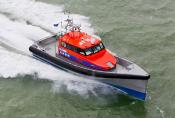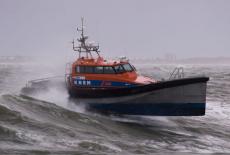Prototype KNRM Dutch Lifeboat NH1816

01.03.2017

Prototype KNRM Dutch Lifeboat NH1816
In 2008 the Royal Netherlands Sea Rescue Institution (KNRM) expressed its need for a completely new type of rescue vessel.
Thanks to a donation to the KNRM from Dutch insurance company ‘Noordhollandsche 1816’ (NH 1816), the design phase could begin in collaboration with Damen, the Maritime Technology faculty at Delft University and De Vries Lentsch Naval Architects.
The KNRM’s rescue vessels, which have to be deployable in all weather conditions, are being designed to the most rigorous standards. Seakeeping and stability are the most crucial factors in safety. For the crew, however, comfort and user-friendliness are also key features. Built by Damen Shipyards Group, the 19 metre rescue vessel named ‘NH1816’ combines all of the technical, ergonomic and operational features the KNRM wanted in a remarkable new design.
Capsizing - Then Sailing On To Complete The Mission
The latest rescue vessel passed one of the most important trials it had to pass before being entrusted to its crew. The capsize trials had to show that this youngest generation of rescue vessel is actually capable of righting itself. In four different tests, at Damen Shipyards Group in Gorinchem, the rescue vessel righted itself to its normal position within a few seconds of capsizing. A life-saving feature in extreme conditions.
The rescue vessel’s self-righting capability was created by the vessel’s low point of gravity and the air bubble in the wheelhouse, which enable the capsized ship to right itself quickly like a self-righting bath toy. The engines and equipment on board are designed to continue operating even after the vessel has capsized.
In its nearly 200-year history, the KNRM has lost 69 rescuers to drowning. Most of those drownings occurred when rescue rowboats capsized in the first 100 years. The advent of motorised, self-righting rescue vessels not only increased safety, but deployability as well. Nowadays, rescue missions under weather conditions that would have forced rowboats to abandon their mission can simply continue. This means that risks have increased as well.
Since 1990, at least twelve rescue vessels have capsized. Two of them, from Terschelling and Ameland, were examples of the largest category of rescue vessels and were able to handle extremely poor weather conditions. Thanks to their unique features, the rescue vessels were able to continue sailing and bring their crews of volunteers safely back to shore.
Further Information NH1816 >
Deployment of NH 1816
After completion of extensive trials the KNRM will deploy the NH 1816 from IJmuiden, with a permanent captain and an on-call crew. Sailors along the entire coast will carry out trials and familiarise themselves with the vessel...
IMAGE CREDIT: Koninklijke Nederlandse Redding Maatschappij (KNRM)
The rescue vessel is intended to be the future replacement for the current Arie Visser-class vessels. These ten 19 metre rescue vessels began being built in 1999 and they continue to deliver outstanding performance. Over the next 20 years, in order to keep the KNRM in line with the latest global developments in rescue work, these vessels will gradually make way for the new generation of rescue vessel.
General information NH 1816:
Type: Fast, all weather, self-righting, day/night lifeboat
Functions: SAR (Search & Rescue) operation and SAR On Scene Coordination
Launhch: Afloat, harbour based
Design: De Vries Lentsch Yacht Designers and Naval Architects, Damen Shipyards, KNRM
Engineering: Damen Shipyards in cooperation with KNRM
Classification: Lloyds Register, notation: ✠ 100 A1, SSC Patrol, HSC, G3[✠] LMC.
Specific requirements to be met (compared to Arie Visser Class):
Significant reduction of vertical and horizontal accelerations (G-forces). Aiming for a minimum of 40%
Significant noise reduction. Set at max 75 Db
Wheelhouse climate control and other increased crew comfort items
Reduction of vibrations
Focus on ergonomically sound wheelhouse design
Focus on restricted emission (meet IMO tier 2 - 3 emission standards) and other environmental aspects (outside noise)
Obtain easier and more effective, planned maintenance.
All images are copyright RIB & HSC 2024 unless otherwise stated.
This does not exclude the owner's assertion of copyright over the material.
09.07.2024
NEXT GEN Marine BATTERY Workshop via Teams
NEXT GEN Marine BATTERY Workshop is being held via…
05.01.2024
The Challenges of Unpredictable Marine Energy
From military to superyacht, it is clear there is an urgent…
Southampton International Boat Show 2024
Dates:
13 to 22 September 2024
Location:
Southampton UK
Foiling and Flying RIBs
Foiling powerboat designed to meet military needs - fast, stable, silent, fuel-saving. Collaboration by SEAir Foiling Systems and Sillinger RIBs.…

















